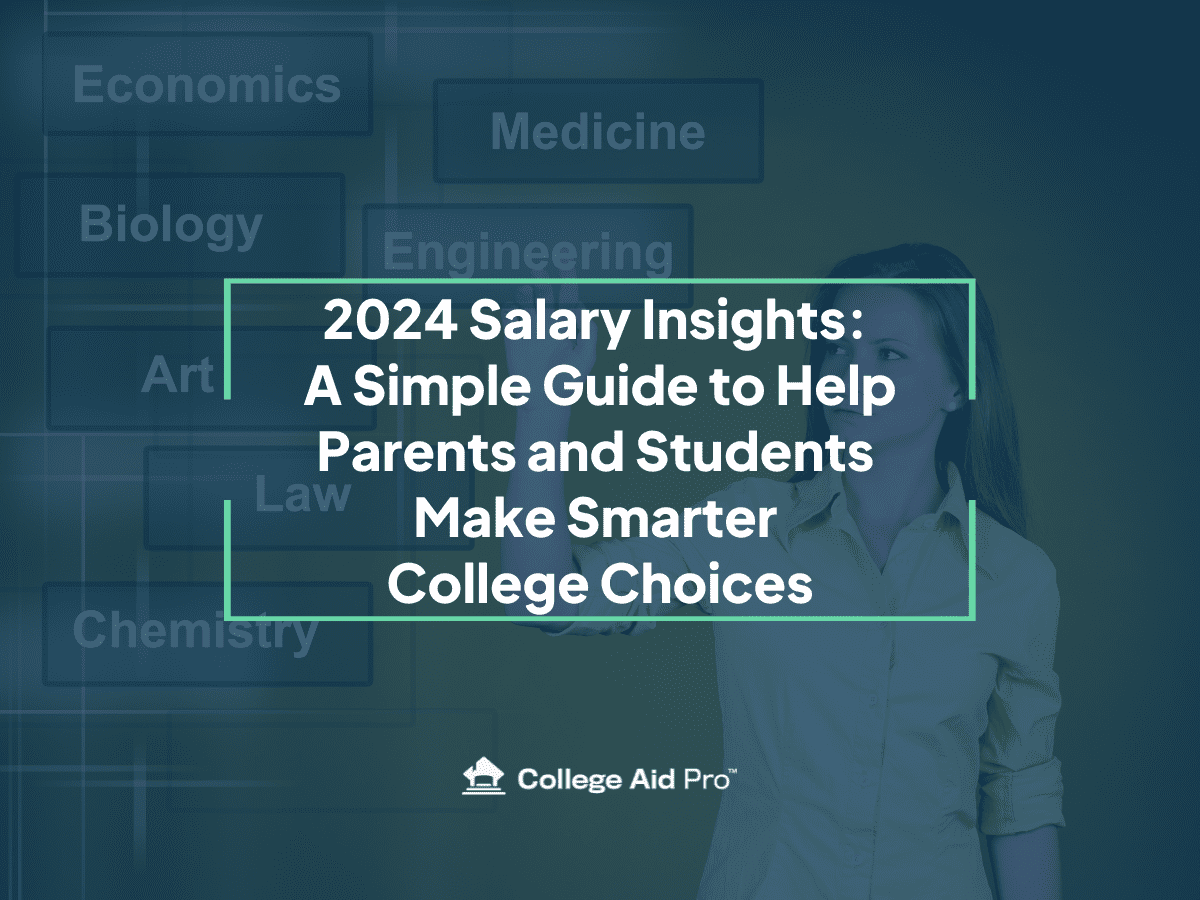As college costs rise, understanding the potential payoff (or “return on investment”) of different degrees is more important than ever. For families just starting the college search, the financial side of college can feel overwhelming. One helpful tool is looking at current salary data for different majors. This data shows how much new graduates in different fields are likely to earn, giving families insights to help decide if the cost of a degree from a specific school is worth it.
Our recent salary data for 2024 highlights some big changes in starting salaries across majors. By comparing this with data from 2022, we can see trends that might shape students’ job prospects after graduation. This data, provided by Job Search Intelligence (JSI) – an industry leader in labor market analytics and salary data – powers the salary insights in our MyCAP software platform. With MyCAP, families can explore specific salary outcomes by major and institution, giving them the information needed to make thoughtful choices about their investment in higher education. Let’s go over some of the key findings, including valuable insights from Paul Hill, president and founder of Job Search Intelligence, to get a better sense of the trends impacting salary data.
Why Salary Data Is Important When Choosing a College or Major
When families consider colleges, they typically look at location, reputation, and cost. But one factor that often gets overlooked is how much a student might earn with a degree in a specific field. Knowing the potential salary of different majors can help answer questions like:
- Will this major lead to a job that pays well enough to make the cost of this college worthwhile?
- How much student debt is manageable based on expected starting salaries?
- What fields are in high demand, and which ones aren’t growing as quickly?
With accurate salary data, families can make smarter, more financially sound choices about college. This data is a helpful guide for students and families to discuss and compare majors, helping them weigh school costs against potential career paths and future salaries.
Major Trends in the Job Market: Insights From Paul Hill

Paul Hill, president and founder of Job Search Intelligence, has observed several shifts in the workforce since COVID-19. Here are a few key insights:
- Entry-Level Jobs Pay More: When COVID-19 hit, millions of people left the workforce, especially in fields like hospitality. This created openings for younger workers without college degrees, raising wages for entry-level jobs from around $9–$10 per hour before COVID to $15–$20 per hour by 2022.
- Demand Grows in Some Fields, Stays Low in Others: Healthcare remains a high-demand field with jobs increasing by 20–25% due to an aging population. Accounting and finance also saw demand rise, with many retirements opening up positions in these fields. Meanwhile, demand for information technology (IT) has slowed slightly.
- Caution Among Employers: As of 2024, many companies are more careful with hiring, and layoffs may increase in some industries. While opportunities may shrink in some areas, steady or growing demand in fields like healthcare and accounting can give families confidence in these majors.
What Our Salary Data Reveals
We gathered salary data from over 1,200 schools and 55 majors to uncover which fields have seen the biggest increases in starting salaries over the past two years—and which ones have grown more slowly. This information can help families assess which majors might offer a better return on investment.
Majors with the Biggest Salary Growth
From 2022 to 2024, average starting salaries for new graduates went up by 12.8%, but some majors saw even greater growth. Here’s a look at some of the majors with the highest salary increases:
| Major | Salary Growth (%) |
| Art/Art Studies | 40.08% |
| Special Education and Teaching | 33.97% |
| Applied Mathematics | 28.18% |
| Physics | 24.16% |
| Public Relations, Advertising, and Communication | 23.09% |
These fields reflect strong job growth, especially in areas like STEM (Science, Technology, Engineering, and Math) and healthcare. High demand in these fields has pushed starting salaries higher, making them solid options for students who want good earning potential right out of college.
Majors with Slower Salary Growth
Not all fields have seen strong growth in starting salaries. Here are a few majors with lower-than-expected salary growth between 2022 and 2024:
| Major | Salary Growth (%) |
| International Business, Trade, Commerce | 4.58% |
| Statistics | 4.15% |
| History | 3.82% |
| Health Services, Allied Health, Health Sciences | 3.38% |
| Management Information Systems | 2.46% |
Majors in these fields can still lead to rewarding careers, but starting salaries might be lower. Families considering these majors may want to be cautious about taking on too much debt, as the salaries may not grow as quickly in the coming years.
Average Starting Salaries by Major
While salary growth shows recent trends, average starting salaries give a sense of what new graduates in different fields might expect to earn. Here are some of the majors with the highest average starting salaries in 2024:
| Major | Average Starting Salary |
| Applied Mathematics | $90,776 |
| Computer Science | $88,839 |
| Computer Engineering | $84,094 |
| Statistics | $78,334 |
| Electrical and Electronics Engineering | $77,983 |
Majors like applied mathematics, computer science, and engineering provide higher starting salaries, reflecting the demand for technical skills in today’s job market. These fields offer clear paths to well-paying jobs right out of college, which can help offset college costs if loans are part of the plan.
If your student is considering majors with higher starting salaries, it may make sense to look at colleges with slightly higher tuition costs. At College Aid Pro, we recommend not borrowing more than the expected starting salary after graduation. So, for majors like computer science or applied mathematics—where graduates can earn $80,000 or more—taking on student loans within that range may be a manageable choice, as their earning potential can support repayment comfortably.
On the other hand, here are some majors with the lowest average starting salaries in 2024:
| Major | Average Starting Salary |
| Biology/Biological Sciences | $50,046 |
| English Language and Literature | $49,489 |
| Music | $49,440 |
| Human Resources Management | $49,359 |
| Early Childhood Education and Teaching | $48,769 |
These fields may have lower starting salaries, but they still offer rewarding career paths. Many students who choose these areas value the opportunity to be creative, make an impact, and enjoy a high level of personal satisfaction.
If your student is drawn to one of these fields, keep in mind that a lower expected starting salary might mean being more cautious with loans. Additionally, if a student combines a humanities or arts major with a minor in a high-demand area, it can potentially boost their earning potential and expand career options, making loan repayment more manageable.
How Salary Data Can Help Your College and Career Planning
As you and your student consider college and career options, salary trends like these
can offer helpful insights. Here are a few ways you can use this information to make more confident choices:
- Focus on High-Growth Fields: If your student wants a field with strong financial potential, consider majors with higher salary growth, such as applied mathematics, engineering, or healthcare-related fields.
- Explore Job Stability in Growing Sectors: Some fields, like healthcare and finance, have shown steady demand and may offer more job security. Pairing a major with an in-demand minor, such as business with a healthcare administration focus, can create additional career opportunities.
- Weigh ROI for Different Majors: If salary is an important factor, consider majors that align with your financial goals. While some fields may offer lower starting pay, they can lead to rewarding careers and growth opportunities. For those interested in fields like teaching, early childhood education, or the arts, planning for graduate education or combining majors can also open up new paths.
How Can I see Salary Data in MyCAP?
- Set up your free MyCAP account here.
- Complete the Personal Info by clicking on the word “Profile” in the upper right hand corner of your screen. In the Student Info section select your intended major from one of 50+ options available. Can’t find your exact major? Pick something that is similar or related to your interest.

Inside the Personal Info section of your MyCAP Profile 3. Once you add schools to your dashboard, you can click on “More Info” in the school tab to learn more. You’ll find admissions criteria, information on financial aid, and the salary insights for your selected major for Year 1, Year 5, and Year 10.

Click on More Info in the school tile to learn more. 
Click the blue arrow by Outcomes to find our salary data for the school and your intended major
Final Thoughts: Finding the Right Balance Between Passion and Practicality
Choosing a college and a major is a big decision, and it’s normal to feel a bit overwhelmed. Salary data can help you see the bigger picture and feel more confident about the future. By understanding which fields are in demand and what different majors might pay, you and your family can make informed choices that strike a balance between what excites you and what makes sense financially.

At the end of the day, the goal is to find something you love and a career you’re excited to wake up to each day. Our MyCAP platform is here to give you tools to explore specific majors, schools, and career paths that match both your passions and your budget. Sign up for a free MyCAP account to access all the insights you need to help make the right choice.
With a mix of data and a focus on what truly matters to you, you can make informed, confident decisions about the future that are both personally rewarding and financially smart.



